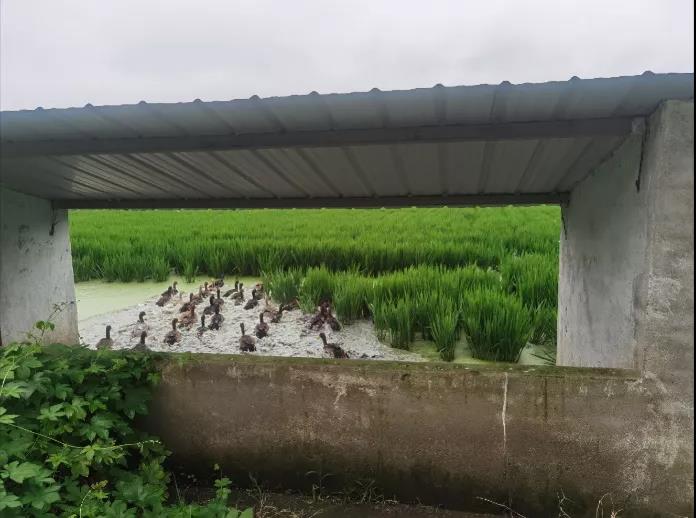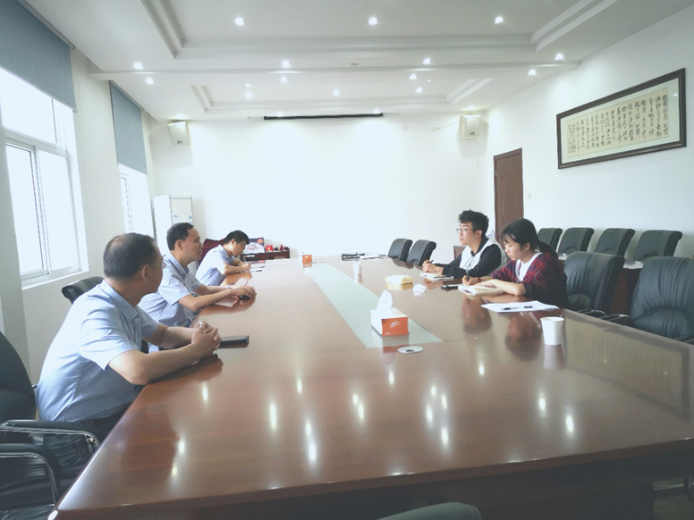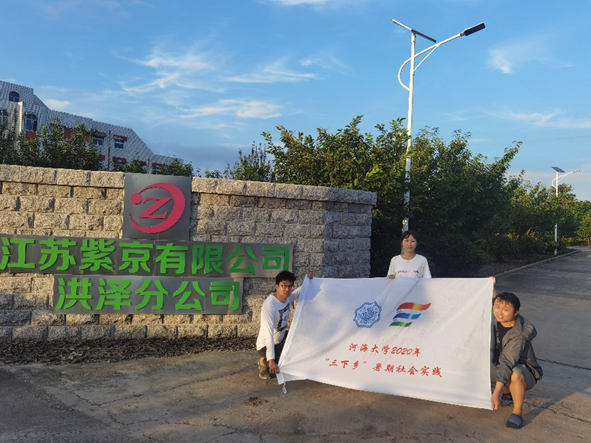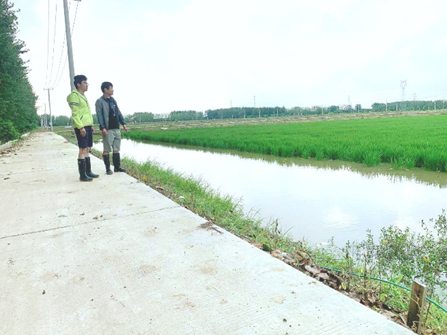In the scorching summer, cicadas are screaming. The "Hongjin Irrigation Area Ecological Planting and Breeding Model" research team from the Faculty of Agricultural Science and Engineering of Hohai University arrived at the Hongze Branch of Zijing Co., Ltd. in Hongjin Irrigation District, Huaian City, Jiangsu Province, in 2020 Summer social practice will be carried out from August 6th to August 10th. The instructors of the investigation team included Dean Chen Jing and postgraduate counselor Zeng Xin. The members included 18 masters Jiang Jiao, Zhao Siyuan, Wu Zhuangzhuang, Li Xuechun and 18 undergraduates Liu Yuan and Gao Qixian. The five-day practice is like a white horse, but the research team has always adhered to the concept of hard work, simplicity and courage to explore, getting close to the countryside and going deep into the fields. In the warm wind, there is the breath of sweat and the comfort of harvest.
First arrived at Zijing Co., Ltd. to understand the general situation of ecological planting
After arriving at the destination, the research team visited the surrounding ecological planting and breeding model demonstration area, and had a preliminary exchange with the person in charge of Zijing Co., Ltd. to learn about the company's general situation. On the first day of social practice, although it was a busy day, it did not reduce the enthusiasm of the investigation team. After seeing the sweat of the working people, the research team further strengthened its determination to help the revitalization of the countryside, defying difficulties and going forward courageously.
Meet with relevant leaders, first enter the depths of the rice fields
In the conference room of the Hongze Branch of Zijing Co., Ltd., the research team had a friendly exchange with Director Sun Haibo and Director Chen Shiliang of Hongjin Irrigation District Management Office and Deputy Director Zhang Shirong of Zijing Co., Ltd. The investigation team learned that Hongjin Irrigation District is a large-scale natural plain irrigation area in the country, spanning Hongze and Jinhu counties (districts), with 420,000 mu of cultivated land, 340,000 mu of designed irrigation area, and 314,000 mu of effective irrigation area.
Afterwards, under the guidance of Zhang Shirong, the deputy head of Zijing Co., Ltd., the research team visited the rice fields of Zijing Co., Ltd. to understand the basic situation, and selected traditional rice and three-dimensional rice-duck farming among many paddy fields. The typical research field of three-dimensional cultivation of rice and shrimp for further study.
Walk into the Sanhe Demonstration Base and learn about the rice-shrimp symbiosis model
After visiting the rice and shrimp integrated planting and breeding model demonstration area, the research team learned about the specific conditions of the rice and shrimp symbiosis model from the management personnel of the rice and shrimp base, including the amount of shrimp fry input, input time, rice and lobster output, input and output, etc. Observe the growth of shrimp and rice in the field. The rice-shrimp symbiosis demonstration area in Sanhe Town covers an area of 1300 mu. The integrated ecological rice-shrimp farming can effectively reduce the use of pesticides by more than 50% and the use of chemical fertilizers by more than 20%, which is conducive to ensuring food safety and improving the agricultural and rural ecological environment.
Walk into the Sanhe Demonstration Base and learn about the rice-duck symbiosis model
The investigation team learned about the specific conditions of the rice-duck symbiosis model from the managers of the rice-duck base, including duck seedling input, input time, rice and ecological duck output, input and output, and in-depth field observation of the growth of duck and rice. The rice-duck symbiosis demonstration area in Sanhe Town covers an area of 1545 mu, with an average of 5-8 ducks per mu. They are put in the middle of tillering of rice and harvested before rice heading. During this period, the rice field maintains a water layer of about 10cm and the agricultural canal maintains a high water level. For ducks to move and forage, there are anti-escape nets built around the paddy and duck fields, and duck houses are built on the north and south sides of the paddy fields for ducks to roost and supplement feed. Through the cultivation of the rice-duck symbiosis model, economic benefits have been improved.
Field investigation of typical fields and understanding of traditional rice cultivation
The research team investigated the basic situation of two typical fields of traditional rice cultivation and learned that the organic rice field is about 2,000 mu, which will be planted on May 22 and harvested in November. Apply organic fertilizer and rapeseed cake, use long-lasting organic fertilizer one month before the soaking period, and do not apply fertilizer, herbicides and pesticides after transplanting. In order to suppress weeds, it is necessary to maintain a shallow water layer in the field, so the irrigation volume is relatively large. Conventional paddy field is the planting mode with the largest proportion in Hongjin Irrigation District, about 269,200 mu. Compound fertilizers and pesticides are used normally, and seedlings are planted on June 23, and harvested at the same time as organic rice. Since the growth period is about one month shorter than that of organic rice, the amount of irrigation is relatively small. While investigating traditional rice fields, team members discovered some existing problems in Hongjin Irrigation District and put forward relevant ideas based on their professional knowledge. Only by keeping in mind and implementing the water-saving policy of “prioritizing water-saving, spatially balanced, systematic governance, and two-handed effort” put forward by General Secretary Xi Jinping, and efficient use of agricultural water resources can we truly achieve agricultural water saving and promote sustainable agricultural development.
The heart of agriculture and water, the love of rivers and seas
Time is like an arrow, and social practice is coming to an end in a blink of an eye. In this short and substantial five-day period, the research team has gained a lot. It not only learned about the characteristics of traditional rice planting, integrated rice and shrimp cultivation, and integrated rice and duck cultivation mode. In the process of going deep into the field, we also discovered the remaining problems in the irrigation area. “It’s always shallow on paper, and you must do it yourself.” The knowledge in books is the foundation of the theoretical foundation after all. There is often a gap between reality and theory. Only when you truly experience it yourself, visit and observe, and connect theory with practice can you have Deeper understanding. After this practical activity, the research team will continue to uphold the spirit of “hard work, simplicity, and courage to explore” of Hehai people, focus on agriculture and water, and contribute to the revitalization of the countryside.





